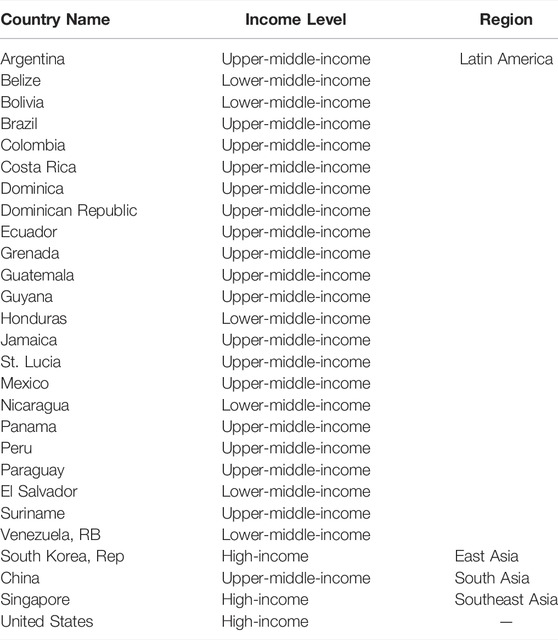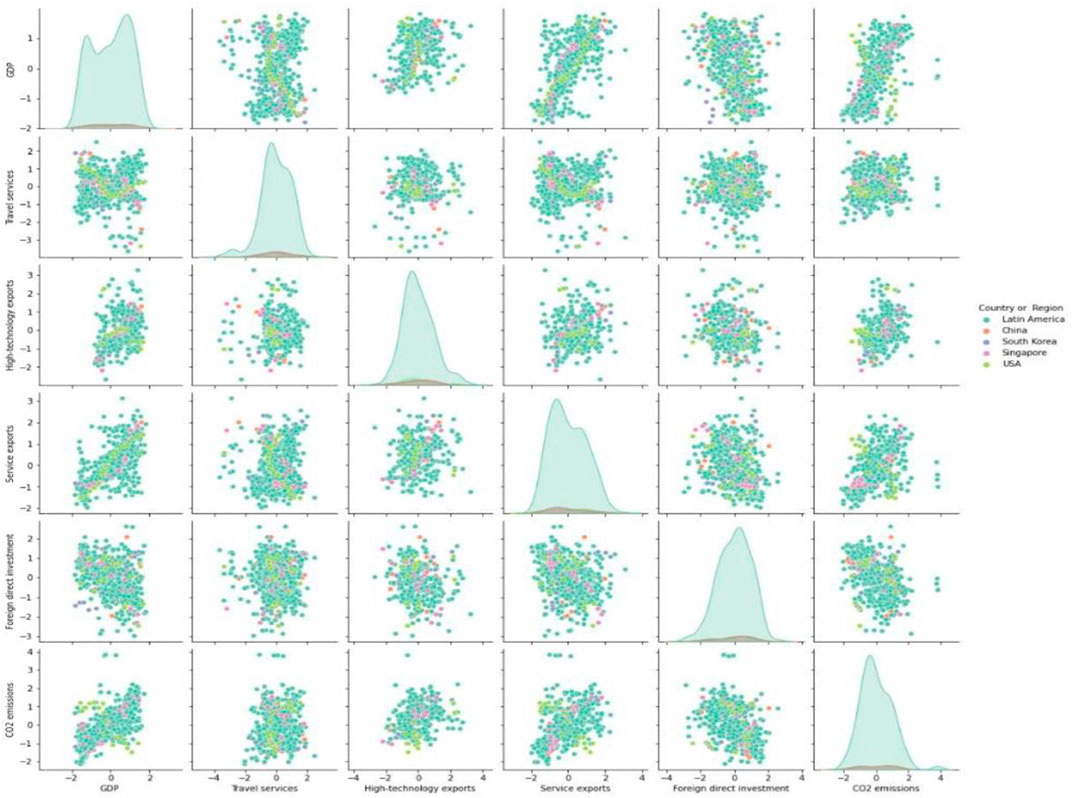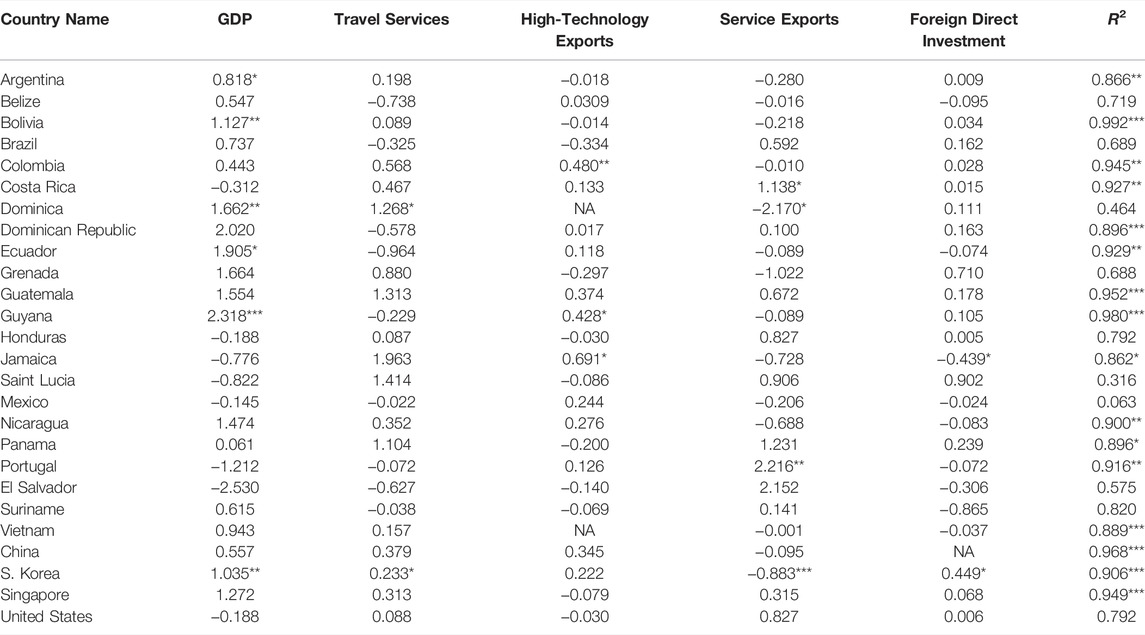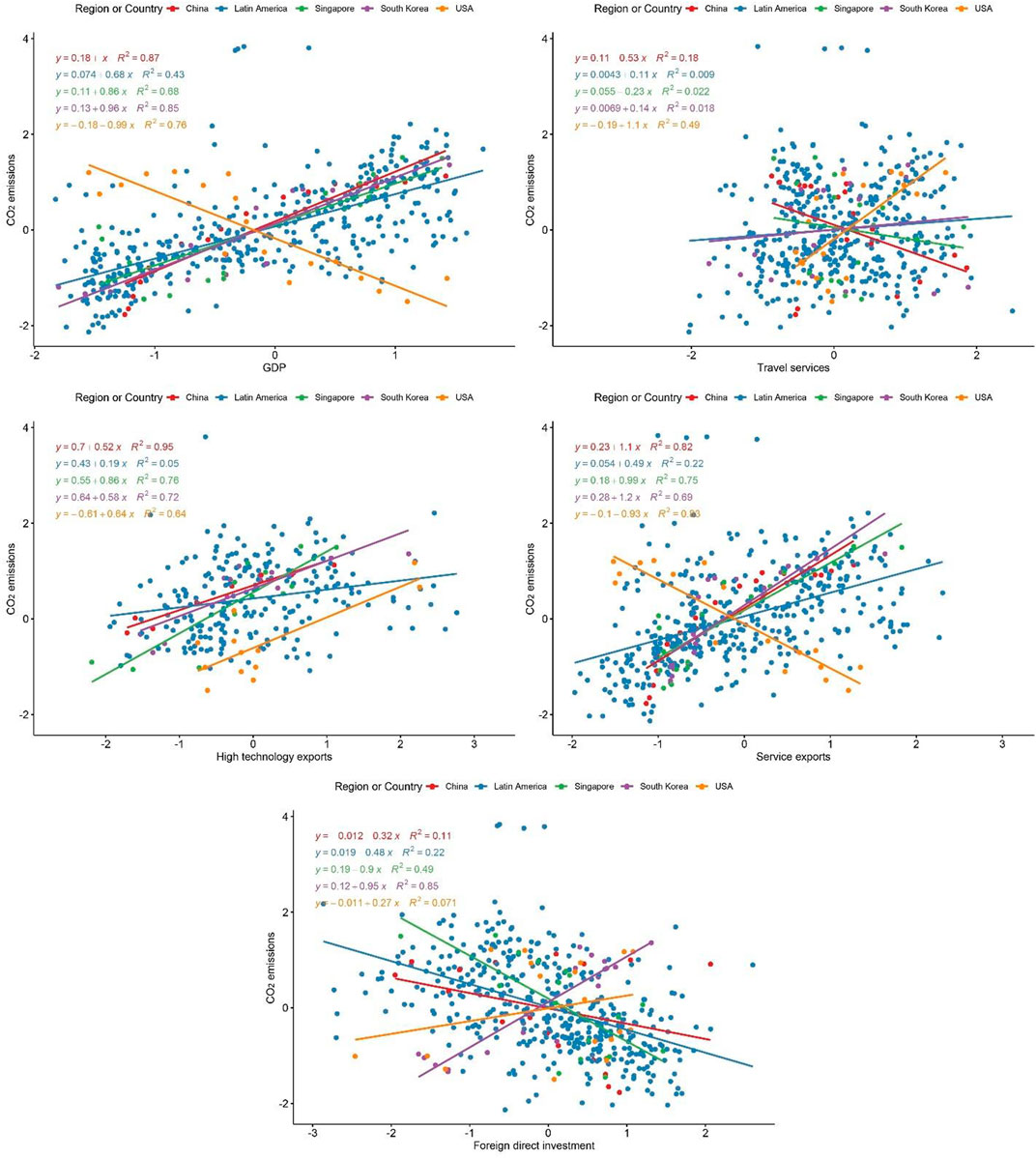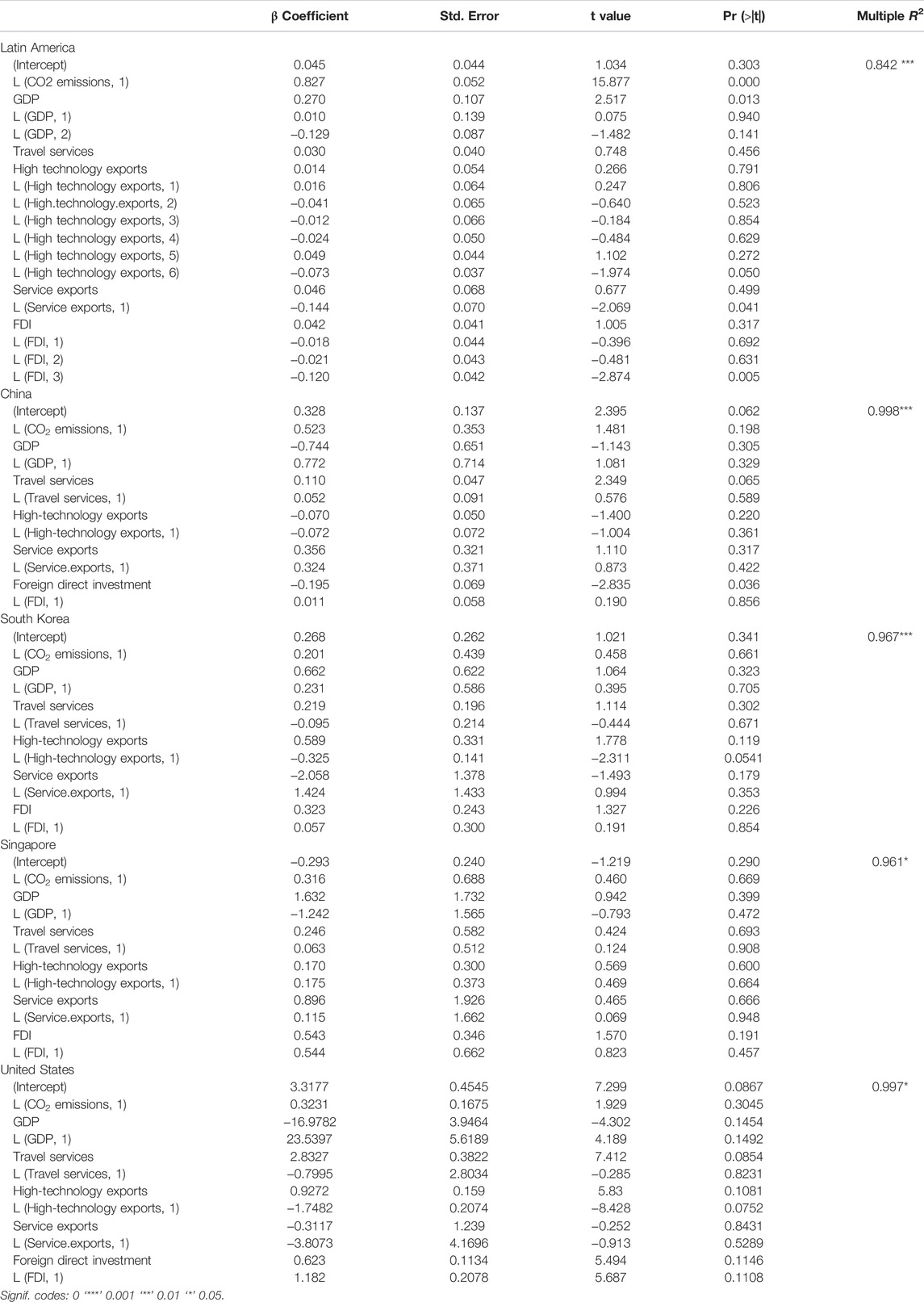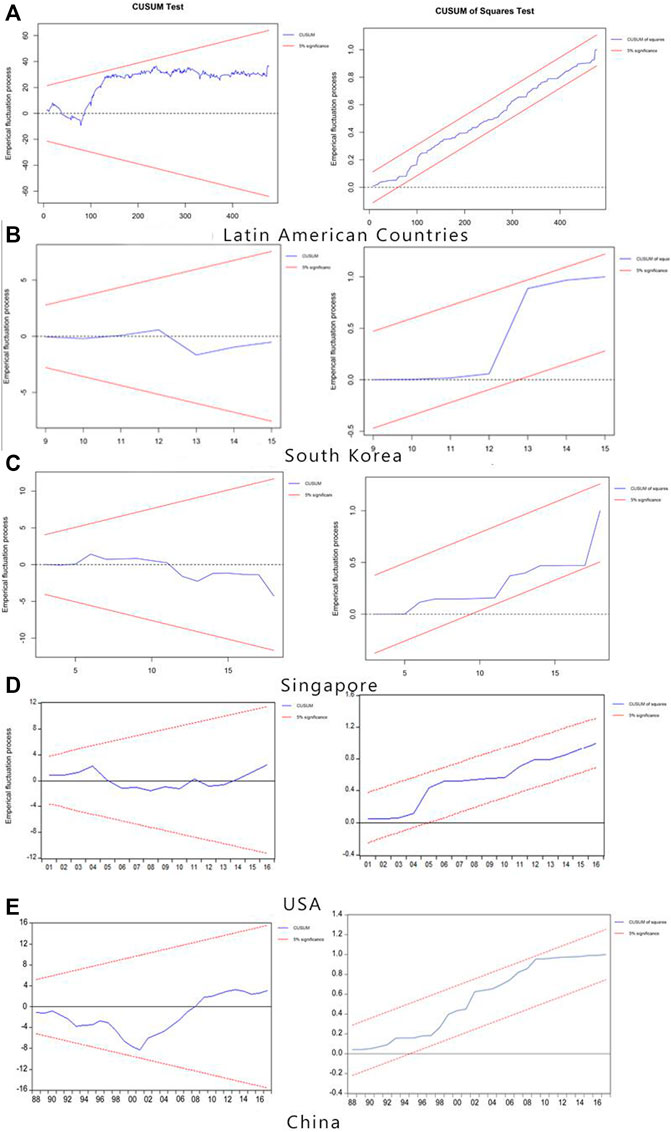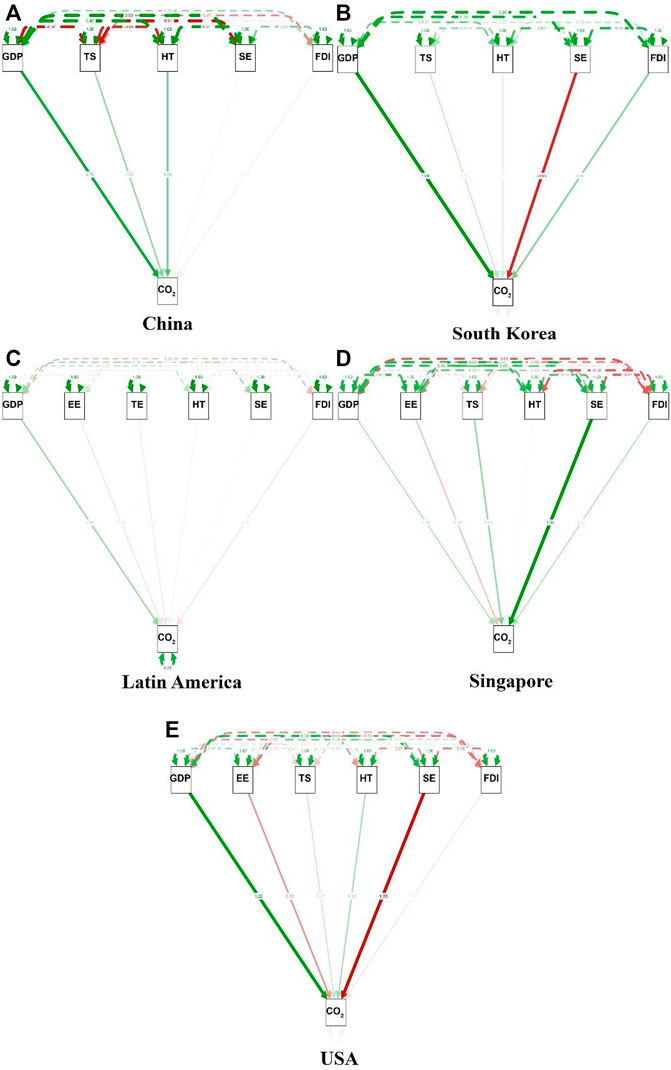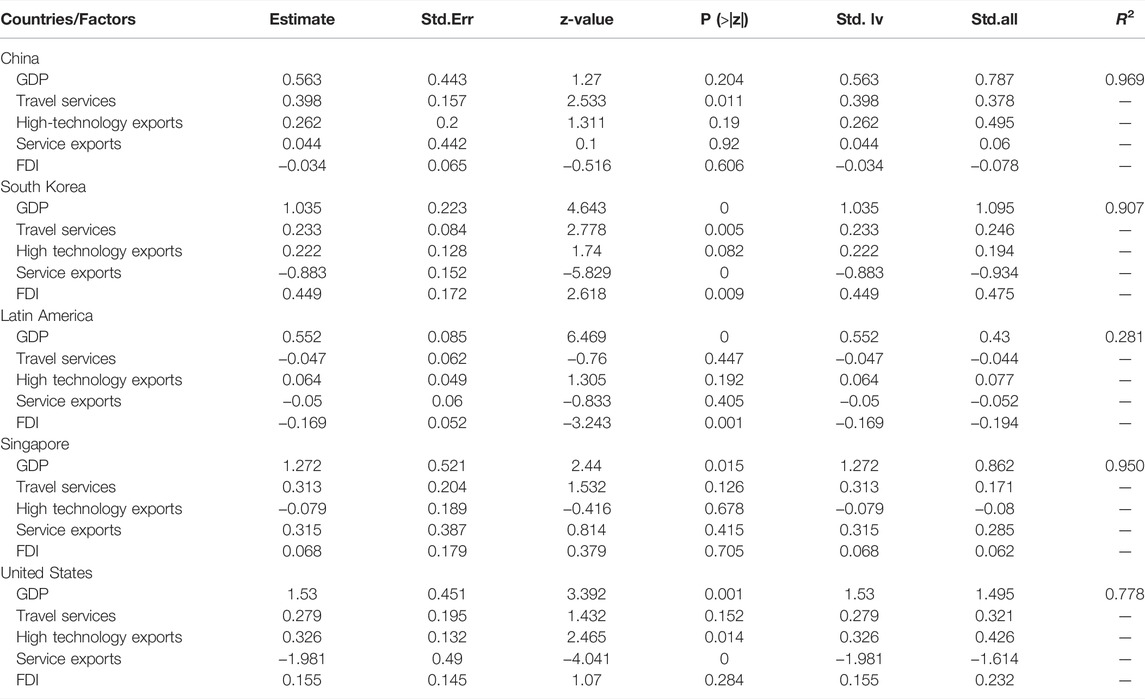- 1School of Economics and Management, Southeast University, Nanjing, China
- 2College of Information and Communication Engineering Hainan University, Haikou, China
- 3Department of Economic Science, Management and Accounting, Universidad de la Costa, Barranquilla, Colombia
- 4Corporación Universitaria Americana, Barranquilla, Colombia
In recent years, the carbon dioxide emissions generated by the massive consumption of fossil energy have been increasing year by year, resulting in more and more obvious greenhouse effect, and the occurrence of climate disasters around the world has become more and more frequent. This study analyses the long-term effects of economic growth, trade, foreign direct investment (FDI) and gross domestic product (GDP) on carbon dioxide (CO2) emissions in Latin American countries that are in the middle-income trap (MIT). Using annual time-series data for the period 2000–2020, the results of middle-income countries of Latin America are compared with higher-income countries (Singapore, the United States, and South Korea) and an upper-middle-income country, China. Specifically, we examine the role of sector value addition to GDP on the CO2 emission nexus for middle-income economies, controlling for the effects on GDP, FDI, and trade. Using regression and path analysis (multiple regression) we find that for higher-income countries FDI, GDP and trade are the important variables that have a strong positive impact on CO2 emission, but that positive impact is weak in MIT countries, which makes this study significant as it highlights important variables needed for MIT countries to remain focused. Autoregressive distributed lag (ARDL) model results also explore that FDI, GDP growth and trade variables can significantly accelerate the environmental quality by CO2 emission, while tourism/travel services and education do not much impact the environment. Hence, our paper provides solid ground for developing a sustainable and pro-growth policy for MIT countries because they are plagued by the decline or stagnation of economic growth.
1 Introduction
With the development of world trade, the economies of various countries, especially developing countries, have achieved unprecedented growth, but at the same time, it has also brought about the problem of increased carbon dioxide emissions, which in turn leads to climate warming (Chunling et al., 2021; Qayyum et al., 2022; Yang et al., 2022). However, there are still many differences among countries on the definition of emission responsibilities and actions taken (Ali and Kirikkaleli, 2022). Developed countries believe that developing countries are currently the main source of carbon emissions, and require less developed countries, including China and Latin American countries, to take greater measures to reduce emissions (Qayyum et al., 2021; Yang et al., 2021; Shabir et al., 2022). The less developed countries pointed out that the accumulated carbon dioxide emissions of developed countries in history far exceeded the current carbon emissions of developing countries, and the commitment of developed countries to provide financial and technical assistance to less developed countries to reduce emissions has not been fully implemented (Yang et al., 2020a; Yang et al., 2020b; Fan et al., 2020). Therefore, developed countries require less developed countries. It is unreasonable for developed countries to shoulder the same level of responsibility for reducing emissions. Such differences in emission reduction actions will have an impact on global carbon emissions (Kirikkaleli et al., 2022).
The rapid development of world trade after World War II has directly promoted the economic growth of various countries, but on the other hand, it has led to the problem of carbon dioxide emissions. Especially in the context of global warming, it is particularly important to divide the emission responsibilities of each country, and the carbon embodied in trade has thus become a subject of research (Bhatti et al., 2021a; Bhatti et al., 2022; Yuan et al., 2022). Debone et al. explored the relationship between Brazil’s economic structure changes and carbon emissions and found that there was a significant correlation between those factors (Debone et al., 2022). In particular, the increase in Brazil’s carbon emissions in the 1990s was largely attributable to the transition to energy-intensive production in its production, in which 6.6% of energy use and 7.1% of carbon emissions were caused by the export sector. In addition, carbon accounting from a production perspective can lead to carbon leakage issues, which raises concerns about shifting carbon emissions. Liu et al. estimated that carbon emissions embodied in global trade reached 5.3 billion tons, and some countries were net importers of carbon embodied in trade, which was related to the country’s size, geographical features, and other national characteristics (Liu et al., 2017).
Many economies can easily grow from a low-income country to a middle-income country, but it is difficult to cross the middle-income stage and become a high-income country (Smit and Pilifosova, 2003; Green and Stern, 2017; Zhang et al., 2017). CO2 emission is one that is playing a vital role in extracting the relationship between MIT and trade. Latin American countries such as Brazil, Argentina, and Mexico jumped from low-income countries to middle-income countries in a very short period of time, creating a miracle of growth in the national economy and per capita income, but they experienced economic regressions one after another between 1970 and 1980 (Parrique et al., 2019). Among Asian economies, only Japan has successfully overcome the “middle-income trap” and achieved a leap in economic development (Taylor, 2005). After being hit by the Asian financial turmoil, Indonesia, the Philippines, India, and other countries have remained in the middle-income ranks because they could not resume their previous prosperous economic development (Kang et al., 2016). The “middle-income trap" (MIT) is a common economic phenomenon that occurs in countries with different historical, cultural, and economic backgrounds, accompanied by declining economic growth and fragile financial systems. In order to help countries, avoid falling into or escape from the “middle-income trap”, many research institutions and scholars have studied its development theories, causes, and avoidance mechanisms (Ozturk and Al-Mulali, 2015). Even if not all countries or regions fall into the “middle-income trap”, they will always be affected by the “middle-income trap” to varying degrees in the process of their economic development (Wang and Zhao, 2015). Few countries or regions can be avoided. In addition to the “middle-income trap” occurring in developing countries, similar phenomena have also occurred in some developed countries in the early stages of development, such as the United States and the United Kingdom (Zhang et al., 2018).
The fundamental reason for the occurrence of the “middle-income trap” is that the engine that supported economic growth in the past was unsustainable (Dinda, 2004; Ran et al., 2020). If a country wants to make a breakthrough in economic development and enter the ranks of high-income countries, it needs to change this stagnant or even retrogressive economic state, adjust the backward growth mechanism, and inject new impetus into economic development (Su, 2017). From the perspective of international trade, the root cause of the “middle-income trap” is that with the rapid social and economic development, middle-income countries have ushered in opportunities for development. When the economy grows to a certain level, the advantages of labor no longer exist, and labor remuneration continues to increase, but the economic structure has not been upgraded, and the international competitiveness has been further weakened (Edwards, 2017). Therefore, the international trade situation has not only not improved year-on-year but has deteriorated, and the industrial structure has not been improved. To optimize and adjust, economic development has fallen into difficulties, which has caused social turmoil and intensified social contradictions, and the economic development of middle-income countries has fallen into difficulties (Susilo, 2021); (Gonçalves and Salles, 2008).
The arrival of the industrialization era not only made the world economy develop rapidly but also released a large number of greenhouse gases, thus causing global warming. In this process, CO2, as the main component of greenhouse gases, plays a major role (Kaygusuz, 2009). The damage by global warming hinders the sustainable development of the economy and affects human health at the same time. At present, the issue of global warming has received widespread attention, and CO2 emission reduction has become an important issue for all countries. Therefore, in the process of economic development, the question of when the kuznets inflection point of CO2 emissions comes and whether relevant measures can be taken to make the inflection point come earlier, is particularly important. Therefore, many scholars have commenced studies on the impact of economic development on CO2 (Khan et al., 2020).
Saud et al. (2019) used cross-sectional data from developed and developing countries to conduct an empirical analysis of the correlation between economic development and environmental pollution, thus formally launching the EKC hypothesis. In fact, before this, scholars had studied the correlation between the above two variables and obtained similar results. Lowering barriers to trade often expands the scale of economic activity, changes the composition of economic activity, and changes production techniques, thereby affecting the environment. The inauguration of the North American Free Trade Agreement comes as U.S. environmental groups voice concerns about the agreement, fearing that free trade could worsen the environment in Mexico while affecting the environment in the United States. Therefore (Grossman and Krueger, 1991), used cross-sectional data from 42 countries to explore the correlation between economic development and air quality, and the results showed an inverted, roughly U-shaped correlation. Galeottia et al. found through empirical analysis that the nonlinear impact of economic development on CO2 emissions presents an inverted U-shape and proved the robustness of this relationship by replacing the relevant data of CO2 emissions in the empirical analysis (Galeotti et al., 2006). Loganathan et al. explored the impact of CO2 tax and economic development on environmental quality in Malaysia with the cointegration test and Granger causality test, using time-series data from 1974 to 2010, and found that economic development and CO2 are directly related with positive relation (Loganathan et al., 2014). There is an inverted U-shaped nonlinear relationship between emissions, and the CO2 tax policy fails to play its role in controlling CO2 emissions (Cederborg and Snöbohm, 2016). and (Yang et al., 2015) also conducted empirical research on the relationship between economic development and CO2 emissions, and the results showed that there was an inverted U-shaped correlation between them (Liu et al., 2016). investigated the joint effects of economic development and urbanization on CO2 emissions based on a partial linear additive model. The impact on CO2 emissions presents a “roller coaster” mode with three turning points. Using the data from 1975 to 1998 of 22 countries that made CO2 emission reduction commitments in the Kyoto Protocol (Mensah et al., 2019), determined to verify by pooled mean group (PMG) whether the environmental Kuznets curve is suitable for CO2. The results show that the nonlinear effect of economic development on CO2 emissions exhibits an N-shape rather than an inverted U-shape (Xiumei et al., 2011). used the VAR model to empirically analyze the dynamic correlation between CO2 emissions and economic development in Zibo City, Shandong Province. The results show that there is no inverse U-shaped correlation in the dynamic sense between the above two variables, but the per capita GDP has a very large contribution to the interpretation of the variance decomposition of CO2 emissions, so the realization of CO2 emission reduction goals is certain (Shuai et al., 2017). combined the STIRPAT model with panel data and time-series data to study the impact of population, level of technology, and economic growth on CO2 emissions in 125 countries with different incomes levels, from 1990 to 2011. It shows that from a global perspective, the key factor affecting CO2 emissions is the degree of economic development, but for high-income countries, the level of technology has the greatest impact on CO2 emissions.
There are two aspects of innovation:
• First, an ARDL is employed in a way that has never been done before to extract the relationship between trade, FDI, economic growth, and CO2 in Latin American nations that are a part of the MIT.
• Second, the impact of CO2 emissions in higher-income countries and MIT countries is explored. MIT Latin American countries are supplied with policy advice regarding the factors that need to be focused on.
The remainder of the study is structured as follows. The section Literature review describes the impact of MIT on economic growth. Section methodology describes the data source, and techniques used for analysis using ARDL. shows the estimation outputs of the panel data estimators. Discussion on findings and implications with conclusion is provided in Section discussions and conclusion. The conclusion describe the policy recommendation and future prospects of this study.
2 Methodology
2.1 Study Area and Data Description
Latin America refers to central America, the Caribbean, and South America, all south of the United States. It is named thus because most countries use Spanish and Portuguese, both of which belong to the Latin family, as their national languages. Located in the central and southern parts of the western hemisphere, it is bordered by the Atlantic Ocean in the east, the Pacific Ocean in the west, bordering North America (United States) in the northwest, and facing Antarctica across the Drake Passage in the south. There are 33 countries in Latin America, out of which we selected a total of 19 countries and categorized them according to their income level i.e., upper-middle- and lower lower-middle-income. We selected three higher-income countries, the United States, Singapore, and Korea, as models for comparison as they had escaped the MIT. China is also selected although it is an upper-middle-income country but will probably leave this level due to its silk road and other programs (Sener and Karakas, 2019). Table 1 shows the list of the selected countries.
2.2 Data Selection
Data for different factors have been selected from the World Bank website for the period from 2000 to 2020 for the selected countries (Glawe and Wagner, 2020). The focus factors that impact the MIT are health, GDP, travel services/tourism, trade (high-technology exports, information etc.), and FDI. Descriptive analysis of the data is shown in supplementary material A. Statistical analysis of the data was performed using SPSS software (version 25; IBM). Results of statistical analysis are shared in supplementary material A.
2.3 Regression Model
This paper uses regression analysis to obtain the relationship of variables that impact CO2 emission. Regression analysis is a method of making predictions on continuous data. The purpose is to analyze whether two or more variables are related, and the direction and strength of the relationship. Regression analysis can observe specific variables by building mathematical models or predict variables of interest to researchers.
The simplest regression model can be represented as the data object to be fitted is
Where w is the regression coefficient, we use a square error to measure the fitting error:
The above formula is equal to 0 to the w.
It can determine:
The above is easy to interact with training data; a good solution is partial weighted linear regression, increasing a weight
Among them, W is a diagonal matrix, also called the core; the type of core can choose freely, and the most common is the Gaussian nucleus. The weight corresponding to the Gaussian nucleus is as follows:
Similarly, the new error function L (X) is governed to obtain the regression coefficient at this time:
The W here is actually
2.4 Path Analysis
After linear regression, we applied path analysis for multiple regression. Path analysis multiple linear regression reflects the direct effect between independent variables and dependent variables, but the relationship between variables is often intricate; some are unidirectional influence relationships, and some are mutual influence relationships, so it is often difficult for analysts to use only one regression model (World Bank, 2022).
In path analysis, to distinguish variables with different characteristics, statisticians give them names that reflect their characteristics: exogenous variables, endogenous variables, and final outcome variables. Exogenous variables refer to those variables in the model that only affect other variables and are not affected by other variables. Endogenous variables are the exact opposite of exogenous variables, referring to variables that can both affect and be affected by other variables in the model. If the endogenous variable is only affected by other variables, but not affected by other variables at all, such an endogenous variable is called the final outcome variable.
Path analysis includes the following four ways:
• A may have an effect on B, but B will not affect A. (A→B)
• B may have an effect on A, but A will not affect B. (A←B)
• There is a two-way influence relationship between A and B. (A←→B)
• The exact mode of influence between AB is unknown, but there is a correlation.
If the coefficients in the path analysis model are statistically significant, the problem will be much simpler, which may be the result, but when there are coefficients that are not statistically significant in the model, the model needs to be simplified, raising the question of how to evaluate the effect of the simplified model. In path analysis, an endogenous variable corresponds to a regression equation, and each regression equation has a coefficient of determination R2, representing the proportion of the variance of the corresponding endogenous variable that can be explained by the equation, (1–R2), that indicates the remaining unexplained part of the equation.
2.5 ARDL Model
The ARDL model has been in use for decades to model the relationship between economic variables in a single-equation time-series setup. Its popularity also stems from the fact that the cointegration of nonstationary variables is equivalent to an error correction (EC) process, and the ARDL model has a reparameterization in EC form (Aamir et al., 2021). The existence of a long-run/cointegrated relationship can be tested, based on the EC representation. A bounds testing procedure is available to draw conclusive inference without knowing whether the variables are integrated of order zero or one, I (0) or I (1), respectively (Kripfganz and Schneider, 2016).
The regression model studies the analysis of univariate series, while the ARDL model models multivariate time series. In the ARDL model, not only the lag part of the original data, but also other influencing factors are added to adjust the autoregressive results.
The specific definition of the autoregressive (AR) model is shown below.
If
Special attention should be paid to the fact that when
As we all know, time series can be divided into stationary and nonstationary. Similarly, autoregressive series are also stationary and nonstationary. The definition of a stationary autoregressive series of order p is as follows.
Definition 2.3.1 For the p-order autoregressive model (2.3.1), if its coefficients
The p-order autoregressive models involved in this paper are all p-order stationary autoregressive models, and the p-order autoregressive sequences involved are all p-order stationary autoregressive sequences.
3 Results and Discussion
A generally accepted view as to the cause of the MIT is that with economic growth, labor costs increase, and the comparative advantage of cheap labor costs is lost; a new economic growth model guided by knowledge and innovation has not yet been formed, thus making economic growth momentum insufficient. Therefore, the causes of the MIT can be roughly divided into the following three levels: first, the direct impact variables of sustained economic growth, such as education, industrial structure and its changes; second, the internal and external environmental variables affecting economic growth, such as trade, macroeconomic policies, demographic factors, and FDI; and the third is the fundamental reason that affects long-term economic performance, such as social and economic systems, for example, tourism and services (Egawa, 2013; Satrovic, 2017). Given this, travel services, high-technology exports, service exports, and FDI are selected as independent variables affecting a country’s per capita GDP, GDP as an independent factor and carbon emission CO2 (y) as a dependent variable. Table 2 shows the studies which use similar factors in their literature review and experiments.
According to the above analysis, with ln(free), ln(open), ln(con), ln(ind), ln(hon), ln(tec), inf, ln(lab), ln(inv) and ln(ci) as the independent variables and ln(y) as the dependent variable, establish the following panel data econometric model:
where i represents the countries’ element, i = 1, 2,., 14 (here Singapore and Korea are also considered for evaluation); i = 1, 2,...., 26, t represents time,
The results of the Hausman test found that the fixed effects model was the most suitable for the data in this paper. However, the static panel ignores the dynamic influence of the lag term of the independent variable on itself, which may lead to large deviations in the estimation results. Since the economic growth of the previous period has an impact on the economic growth of the current period, it is necessary to introduce the lag term of economic growth to reflect the dynamic lag effect. On the basis of the static panel model, the first-order lag term of the dependent variable is incorporated into the model to obtain the dynamic panel model as follows:
Using the lagged term of the dependent variable as an independent variable will cause endogeneity problems in the regression model. To better deal with the correlation and endogeneity between cross-sections, regression analysis was performed on the data. First, using correlation analysis between different factors highlights that for high-income countries, such as Singapore, CO2 emission has a strong correlation with GDP (0.825**), high-technology exports (0.871**) and services exports (0.867**), while there is a negative correlation with travel services (−0.149). South Korea showed a strong correlation of CO2 with GDP (0.922**), high-technology exports (0.849**), services export (0.828**) and FDI (0.920**). The United States demonstrates a strong correlation of CO2 with high-technology exports (0.803**) and travel services (0.300), while there is a negative relationship with GDP (−0.874**). For Latin American countries, a strong correlation of CO2 is observed with GDP (0.907**), high-technology exports (0.774**) and services exports (0.625**), while there is a negative correlation with FDI (−0.760**). China shows a strong correlation of CO2 emission with GDP (0.8935**), high-technology exports (0.974**), and services exports (0.905**), while there is a negative correlation with travel services (−0.422) and FDI (−0.333). These are areas where Latin American countries need to focus by increasing industrialization. Figure 1 shows further detailed comparisons of correlation between regions or countries. Results of correlation analysis are shared in supplementary material B.
The next step is to apply regression analysis to further check regression results. Table 3 shows the regression between different variables with the significance between their relationship with the CO2 of each country. However, Figure 2 shows the relationship of variables with countries and the Latin American region. From Table 3, it can be seen that GDP has significant positive impact on CO2 emission in Argentina (β = 2.182*), Bolivia (β = 1.127**), Dominica (β = 1.661**) and Guyana (β = 2.318***) while other countries specially China (β = 0.557) and other developed countries like South Korea (β = 0.650), United States (β = 2.563) and Singapore (β = 0.578) also have significant positive relationship. FDI shows a positive relationship with CO2 emission in Argentina (β = 0.205), Bolivia (β = 0.034), Brazil (β = 0.196), Dominican Republic (β = 0.316), Grenada (β = 0.710) and Panama (β = 0.239), while it shows a negative relationship with other Latin countries like Ecuador (β = −0.152), Jamaica (β = −0.720), Nicaragua (β = −0.083) and Suriname (β = −0.865). Similar positive and negative relationships are also observed in developed countries like the United States (β = -0.046), Singapore (β = 0.358) and South Korea (β = 0.179). The high-technology exports relationship with CO2 is positive in Argentina (β = 0.125), Belize (β = 0.030), Colombia (β = 0.432), Costa Rica (β = 0.135), Dominican republic (β = 0.057), Ecuador (β = 0.093), Guatemala (β = 0.625),Jamaica (β = 0.896) and Portugal (β = 0.126) while this relationship is negative in other Latin American countries like Suriname (β = −0.069), El Salvador (β = −0.140), Panama (0.200), Saint Lucia (β = −0.086) and Honduras (β = −0.030). For developed countries the relationship is positive in South Korea (β = 0.407), Singapore (β = 0.049) and the United States (β = 0.322).
Figure 2. Taking Latin American countries as a region, the relationship between CO2 and GDP is weak, R2 = 0.43 shows that it is lower, while strong in China (R2 = 0.87) and other developed countries like Singapore (R2 = 0.68), United States (R2 = 0.76) and South Korea (0.85). Similarly, for the trade of high-technology exports and CO2, Latin America has a weak relationship with R2 = 0.05 while other countries have a strong relationship, like China (R2 = 0.95), South Korea (R2 = 0.72), United States (R2 = 0.64) and Singapore (R2 = 0.76). FDI shows a weak relationship with CO2 in Latin America (R2 = 0.22) and China (R2 = 0.11), while for developed countries the relationship is strong, such as South Korea (R2 = 0.85) and Singapore (R2 = 0.49). Trade of services exports is a strong predictor for CO2 emission in China (R2 = 0.82), South Korea (R2 = 0.69), Singapore (R2 = 0.75) and the United States (R2 = 0.93), while it is a weak predictor in Latin American countries (R2 = 0.22). Results of regression are similar to the study by (Wang et al., 2019) where a direct positive relationship between CO2 emission and trade exists in China and Australia. A study by (Khaskheli et al., 2021) indicated a similar results pattern in low-income countries by using the panel smooth transition regression model. This study result confirmed that the nexus between the variables is nonlinear. Moreover, it also shows that high trade and FDI increase the CO2 emissions, but as the economy of MIT states progresses to a higher regime, the association between the two variables becomes significant. (Koengkan et al., 2020), in research on CO2 emission in 18 Latin American and Caribbean countries, also found asymmetric effects on globalization and identified that economic globalization, social globalization and political globalization exert an adverse impact on CO2 emissions.
After collecting significant factors from correlation and regression models, the next step is to validate the results by checking with the ARDL econometric model (Table 4). The result of the ARDL model in Table 3 shows that in the Latin American model the R2 value is 0.597. The lag coefficient β has shown that a weak GDP has a weak impact on CO2 i.e., β = 0.251 for the best lag model. Similarly, high-technology export (β = 0.065) and FDI (-0.065) have a weak impact on CO2 for Latin American countries. For China, the R2 value is 0.998, showing a significant impact of variables on CO2 emission. Lag coefficient β is 0.772 for GDP showing that CO2 emissions are impacted by the economic growth of the country. Similarly, β is weak for services exports (0.356) and FDI (0.011) while negative for high-technology exports (0.070). In South Korea, the GDP has a strong impact on CO2 emissions, where β is 0.497. For travel services β is 0.233 and services export β is 2.328, for FDI it is 0.375 and for high-technology exports it is 0.481, which shows a positive impact on CO2 emission. For Singapore, the R2 is 0.951, showing a strong relationship of variables with CO2. GDP is strongly related to CO2 emission with β = 1.632 and travel services β is 0.063. Similarly, in the United States the CO2 emission shows a strong relationship with GDP with β = 4.603, high-technology exports with β = 0.213 and travel services with β = 0.406. These results were similar to the study by (Hotak et al., 2020) using the long-term ARDL approach and finds a positive relationship between trade balances and CO2 emissions for high-income countries, which is the same as in our study (Sun et al., 2019). results contradicted our study on China because his study finds a negative impact of services trade and a positive impact of FDI, using long-term ARDL. As shown in Figure 3, at the significant level of 5%, both CUSUM and CUSUMSQ curves are within the bounds (the red dotted line is the boundary), suggesting that the stability of the model is proved.
To ensure the stability of the proposed model, an ARDL series is tested by adding the recursive residuals, cumulative sum (CUSUM), and cumulative sum of square (CUSUMSQ) analyses. Figure 3 shows plots of the CUSUM and CUSUMSQ graphs. If the curves of CUSUM and CUSUMSQ remain within the critical range of 5%, it represents the parameter stability and the stability of the model.
Path analyses were used to find the relationship between CO2 (dependent variable) and other factors (independent variable). The path analysis model was used to predict the direct and indirect relationships between the CO2 and the other factors such as FDI, economic growth and trade (Figure 4 and Table 5). β is the correlation coefficient that shows the degree of the relationship. The higher the value of beta, the stronger the association between the variables. It can be observed that for China, the CO2 β coefficient with the GDP is 0.787, whereas it is low but positive for travel services i.e., 0.378, and for high-technology exports it is 0.495. In China, it has a negative relationship with FDI, with the β coefficient being -0.078. For South Korea the results are similar i.e., CO2 emission has a strong relationship with GDP at β = 1.095, a weak relationship with FDI at β = 0.475, travel services at = 0.246 and high-technology exports at β = 0.194. Korea has a negative relationship of CO2 with services exports i.e., β = -0.934. In the United States, CO2 emission has a strong relationship with GDP at β = 1.217, while the weak relationship with high-technology exports is β = 0.421, and travel services it is β = 0.268. FDI and services exports have a negative relationship with CO2 emission with β that is −0.159 and −1.297 respectively. In Singapore, the CO2 emission has a positive relationship with GDP (β = 0.392), travel services (β = 0.533), high tech exports (β = 0.050), services exports (β = 1.386) and FDI (β = 0.366). In the case of Latin America, the CO2 emission has a weak relationship with GDP (β = 0.363) and high-technology exports (β = 0.076), while it has a negative relationship with travel services (β = −0.104), services exports (β = −0.015) and FDI (−0.129).
By using the Granger test, the calculated t-statistics of the lagged value of the ECT indicates that there is a long-run causality from the travel services, FDI, services exports, and economic growth on carbon emissions. The tabulated (F)statistics values (Table 6) indicate that there is a unidirectional causal relationship from travel services, FDI, services exports, and economic growth on carbon emissions. This study is significant for middle-income countries as it focuses on various factors that can help to avoid MIT. Overall, changes in industrial scale, trade structure, marketization and export dependence can explain changes in CO2 emissions to a certain extent. The effects of CO2 emissions from export trade in other industries are very significant, except that there is no scale or structural effect in the mining industry, no structural effect in the leather, fur, down and related products industry, and no market effect in the pharmaceutical manufacturing industry, and no policy effect in the metal products industry (Adebayo and Rjoub, 2021). The combined force of industry scale, trade structure, marketization, and export dependence lead to both negative and positive effects of export trade on CO2 emissions. Purely from an industry perspective, there are obvious differences in the intensity and direction of the impact of the scale, trade structure, marketization degree, and export dependence of various industries on CO2 emissions. Most industries have a negative impact on CO2 emissions, while trade structure has a positive effect on CO2 emissions. That is to say, the expansion of the industrial scale leads to the deterioration of CO2 emissions, while the trade structure has a positive effect. Advances have led to improvements in CO2 emissions; however, there is a big difference between market effects and policy effects. Changes in the degree of marketization and dependence on export trade in some industries are conducive to reducing CO2 emissions (Wenlong et al., 2022). In the long run, the expansion of the industrial scale will still exacerbate CO2 emissions, and the upgrade of the trade structure will promote the reduction of CO2 emissions. Although export trade growth is an important factor affecting CO2 emissions, export trade may not necessarily lead to an absolute increase in CO2 emissions. Therefore, we believe that the fundamental way to reduce CO2 emissions lies in optimizing trade structure and scientifically managing export trade. Future work is directed towards using the latest machine learning methods like recommendation system (Bhatti et al., 2018; Bhatti et al., 2019) or hybrid models (Bhatti et al., 2021b).
4 Conclusions and Policy Implications
4.1 Conclusions
This study compares and analyzes different criteria for determining the MIT in Latin American countries and provides possible reasons for the MIT. Our research finds that the social and economic development of Latin American MIT countries contains some common characteristics, and the findings help us understand the mechanism of the MIT. In South Korea, the United States and Singapore, with an analysis of the proportion of trade exports of various types of export commodities, a reasonable explanation for the difference in the export commodity structure between MIT and non-MIT countries is obtained. For non-MIT countries, the industrial upgrading process seems to be consistent with the flying geese pattern of development, but it is also increasing the environmental issues related to CO2 emissions. Government should either follow green environment policies to reduce the burden of CO2 emissions or develop a sustainable environment policy by creating a trade balance. It follows that industrial upgrading through backward linkages between consumer goods and capital goods is more successful in high-income countries that are not in MITs. For countries that are MITs, there is a tendency to rely on exports of primary products, while industrialization is driven by forward linkages of finished products. Limitations of this study are to its focus on few variables, which can impact on quality on results. In future we will be focused on more high quality variables.
4.2 Policy Implications
From the empirical results of this study, the transfer of environmental load through international trade could be forecasted regularly using the relationship extraction between factors with regression, and long-term impact can be monitored with the ARDL model. The environmental loads of international trade, such as water, land use, and energy use, are considered under the current international division of labor between countries. According to the producer-based responsibility principle, a country has responsibility only for the emissions or pollutants that are generated directly within its borders; a typical case is the international climate change regime. To achieve CO2 reduction targets, countries have the incentive to outsource CO2 emissions to other countries, and both the national and global efforts toward CO2 reduction could be undermined by this “CO2 leakage” phenomenon. Therefore, it would be difficult to devise effective environmental policies if the real distribution and balance of the environmental impacts of trade are not considered. For countries that are facing MIT, it is important to focus on trade factors as the results reveal that in China, trade components are directly impacting the economic growth and CO2 emissions, and other high-income countries show the same results as China. The policy implications of the findings of this study are very direct. It is necessary to develop the consumer goods industry and maintain competitiveness in promoting the upgrading of industries to capital goods through backward linkages. Although there are many problems in the economic development of Latin America, these difficulties can be addressed by economic and social policies. Based on the reasons analyzed above, Latin American governments can implement the following policies:
• Raise the national education level and train workers in advanced technology
• Increase scientific research funding and encourage R&D innovation
• Promote industrial upgrading
• Create a favorable environment for foreign investment and encourage overseas investment to stimulate the economy
• Improve the role of taxation; allow taxation to reduce the gap between the rich and the poor, and increase social welfare
Data Availability Statement
The original contributions presented in the study are included in the article/Supplementary Material, further inquiries can be directed to the corresponding author.
Author Contributions
Data curation, LG, UB, CC; Formal analysis, LG, ST, UB; Funding acquisition, LG; Methodology LG, CC, UB; Project administration UB; Software, LG, UB, Writing—original draft, LG, UB.
Funding
This study was funded by funds from Southeast University.
Conflict of Interest
The authors declare that the research was conducted in the absence of any commercial or financial relationships that could be construed as a potential conflict of interest.
Publisher’s Note
All claims expressed in this article are solely those of the authors and do not necessarily represent those of their affiliated organizations, or those of the publisher, the editors and the reviewers. Any product that may be evaluated in this article, or claim that may be made by its manufacturer, is not guaranteed or endorsed by the publisher.
References
Aamir, M., Li, Z., Bazai, S., Wagan, R. A., Bhatti, U. A., Nizamani, M. M., et al. (2021). Spatiotemporal Change of Air-Quality Patterns in Hubei Province-A Pre- to Post-COVID-19 Analysis Using Path Analysis and Regression. Atmosphere 12 (10), 1338. doi:10.3390/atmos12101338
Adebayo, T. S., and Rjoub, H. (2021). Assessment of the Role of Trade and Renewable Energy Consumption on Consumption-Based Carbon Emissions: Evidence from the MINT Economies. Environ. Sci. Pollut. Res. 28 (41), 58271–58283. doi:10.1007/s11356-021-14754-0
Ali, M., and Kirikkaleli, D. (2022). The Asymmetric Effect of Renewable Energy and Trade on Consumption-Based CO2 Emissions: The Case of Italy. Integr. Environ. Assess. Manag. 18 (Issue 3), 784–795. doi:10.1002/ieam.4516
Bhatti, U. A., Huang, M., Wang, H., Zhang, Y., Mehmood, A., and Di, W. (2018). Recommendation System for Immunization Coverage and Monitoring. Hum. Vaccines Immunother. 14 (1), 165–171. doi:10.1080/21645515.2017.1379639
Bhatti, U. A., Huang, M., Wu, D., Zhang, Y., Mehmood, A., and Han, H. (2019). Recommendation System Using Feature Extraction and Pattern Recognition in Clinical Care Systems. Enterp. Inf. Syst. 13 (3), 329–351. doi:10.1080/17517575.2018.1557256
Bhatti, U. A., Yu, Z., Chanussot, J., Zeeshan, Z., Yuan, L., Luo, W., et al. (2021a). Local Similarity-Based Spatial-Spectral Fusion Hyperspectral Image Classification With Deep CNN and Gabor Filtering. IEEE Trans. Geoscience Remote Sens 60. doi:10.1109/TGRS.2021.3090410
Bhatti, U. A., Yan, Y., Zhou, M., Ali, S., Hussain, A., Qingsong, H., et al. (2021). Time Series Analysis and Forecasting of Air Pollution Particulate Matter (PM2.5): An SARIMA and Factor Analysis Approach. IEEE Access 9, 41019–41031. doi:10.1109/access.2021.3060744
Bhatti, U. A., Zeeshan, Z., Nizamani, M. M., Bazai, S., Yu, Z., and Yuan, L. (2022). Assessing the Change of Ambient Air Quality Patterns in Jiangsu Province of China Pre-to Post-COVID-19. Chemosphere 288, 132569. doi:10.1016/j.chemosphere.2021.132569
Cederborg, J., and Snöbohm, S. (2016). Is There a Relationship between Economic Growth and Carbon Dioxide Emissions?
Chunling, L., Memon, J. A., Thanh, T. L., Ali, M., and Kirikkaleli, D. (2021). The Impact of Public-Private Partnership Investment in Energy and Technological Innovation on Ecological Footprint: The Case of Pakistan. Sustainability 13 (18), 10085. doi:10.3390/su131810085
Debone, D., Martins, T. D., and Miraglia, S. G. E. K. (2022). Modeling Carbon Release of Brazilian Highest Economic Pole and Major Urban Emitter: Comparing Classical Methods and Artificial Neural Networks. Climate 10 (1), 9. doi:10.3390/cli10010009
Dinda, S. (2004). Environmental Kuznets Curve Hypothesis: a Survey. Ecol. Econ. 49 (4), 431–455. doi:10.1016/j.ecolecon.2004.02.011
Fan, H., Hashmi, S. H., Habib, Y., and Ali, M. (2020). How Do Urbanization and Urban Agglomeration Affect CO2 Emissions in South Asia? Testing Non-linearity Puzzle with Dynamic STIRPAT Model. Chin. J. Urban Environ. Stud. 08 (Issue 01), 2050003. doi:10.1142/s2345748120500037
Galeotti, M., Lanza, A., and Pauli, F. (2006). Reassessing the Environmental Kuznets Curve for CO2 Emissions: A Robustness Exercise. Ecol. Econ. 57 (1), 152–163. doi:10.1016/j.ecolecon.2005.03.031
Glawe, L., and Wagner, H. (2020). China in the Middle-Income Trap? China Econ. Rev. 60, 101264. doi:10.1016/j.chieco.2019.01.003
Gonçalves, C. E. S., and Salles, J. M. (2008). Inflation Targeting in Emerging Economies: What Do the Data Say? J. Dev. Econ. 85 (1-2), 312–318. doi:10.1016/j.jdeveco.2006.07.002
Green, F., and Stern, N. (2017). China's Changing Economy: Implications for its Carbon Dioxide Emissions. Clim. policy 17 (4), 423–442. doi:10.1080/14693062.2016.1156515
Grossman, G. M., and Krueger, A. B. (1991). Environmental Impacts of a North American Free Trade Agreement.
Hotak, S., Islam, M., Kakinaka, M., and Kotani, K. (2020). Carbon Emissions and Carbon Trade Balances: International Evidence from Panel ARDL Analysis. Environ. Sci. Pollut. Res. 27 (19), 24115–24128. doi:10.1007/s11356-020-08478-w
Kang, Y.-Q., Zhao, T., and Yang, Y.-Y. (2016). Environmental Kuznets Curve for CO2 Emissions in China: A Spatial Panel Data Approach. Ecol. Indic. 63, 231–239. doi:10.1016/j.ecolind.2015.12.011
Kaygusuz, K. (2009). Energy and Environmental Issues Relating to Greenhouse Gas Emissions for Sustainable Development in Turkey. Renew. Sustain. Energy Rev. 13 (1), 253–270. doi:10.1016/j.rser.2007.07.009
Khan, M. K., Khan, M. I., and Rehan, M. (2020). The Relationship between Energy Consumption, Economic Growth and Carbon Dioxide Emissions in Pakistan. Financ. Innov. 6 (1), 1–13. doi:10.1186/s40854-019-0162-0
Khaskheli, A., Jiang, Y., Raza, S. A., Khan, K. A., and Qureshi, M. A. (2021). Financial Development, International Trade, and Environmental Degradation: a Nonlinear Threshold Model Based on Panel Smooth Transition Regression. Environ. Sci. Pollut. Res. 28 (21), 26449–26460. doi:10.1007/s11356-020-11912-8
Kirikkaleli, D., Ali, M., and Altuntaş, M. (2022). Environmental Sustainability and Public–Private Partnerships Investment in Energy in Bangladesh. Environ. Sci. Pollut. Res. doi:10.1007/s11356-022-19771-1
Koengkan, M., Fuinhas, J. A., and Santiago, R. (2020). Asymmetric Impacts of Globalisation on CO2 Emissions of Countries in Latin America and the Caribbean. Environ. Syst. Decis. 40 (1), 135–147. doi:10.1007/s10669-019-09752-0
Kripfganz, S., and Schneider, D. C. (2016). “Ardl: Stata Module to Estimate Autoregressive Distributed Lag Models,” in Stata Conference Chicago.
Liu, Y., Chen, S., Chen, B., and Yang, W. (2017). Analysis of CO2 Emissions Embodied in China's Bilateral Trade: a Non-competitive Import Input-Output Approach. J. Clean. Prod. 163, S410–S419. doi:10.1016/j.jclepro.2016.02.085
Liu, Y., Yan, B., and Zhou, Y. (2016). Urbanization, Economic Growth, and Carbon Dioxide Emissions in China: A Panel Cointegration and Causality Analysis. J. Geogr. Sci. 26 (2), 131–152. doi:10.1007/s11442-016-1259-2
Loganathan, N., Shahbaz, M., and Taha, R. (2014). The Link between Green Taxation and Economic Growth on CO2 Emissions: Fresh Evidence from Malaysia. Renew. Sustain. Energy Rev. 38, 1083–1091. doi:10.1016/j.rser.2014.07.057
Mensah, I. A., Sun, M., Gao, C., Omari-Sasu, A. Y., Zhu, D., Ampimah, B. C., et al. (2019). Analysis on the Nexus of Economic Growth, Fossil Fuel Energy Consumption, CO2 Emissions and Oil Price in Africa Based on a PMG Panel ARDL Approach. J. Clean. Prod. 228, 161–174. doi:10.1016/j.jclepro.2019.04.281
Ozturk, I., and Al-Mulali, U. (2015). Investigating the Validity of the Environmental Kuznets Curve Hypothesis in Cambodia. Ecol. Indic. 57, 324–330. doi:10.1016/j.ecolind.2015.05.018
Parrique, T., Barth, J., Briens, F., Kuokkanen, A., and Spangenberg, J. H. (2019). Evidence and Arguments against Green Growth as a Sole Strategy for Sustainability. European Environmental Bureau.
Qayyum, M., Ali, M., Nizamani, M. M., Li, S., Yu, Y., and Jahanger, A. (2021). Nexus between Financial Development, Renewable Energy Consumption, Technological Innovations and CO2 Emissions: The Case of India. Energies 14 (Issue 15), 4505. doi:10.3390/en14154505
Qayyum, M., Yu, Y., Nizamani, M. M., Raza, S., Ali, M., and Li, S. (2022). Financial Instability and CO2 Emissions in India: Evidence from ARDL Bound Testing Approach. Energy and Environ., 0958305X2110650. doi:10.1177/0958305X211065019
Ran, Q., Zhang, J., and Hao, Y. (2020). Does Environmental Decentralization Exacerbate China's Carbon Emissions? Evidence Based on Dynamic Threshold Effect Analysis. Sci. Total Environ. 721, 137656. doi:10.1016/j.scitotenv.2020.137656
Satrovic, E. (2017). Financial Development and Human Capital in Turkey: ARDL Approach. Kapadokya Akad. Bakış 1 (2), 1–15.
Saud, S., Chen, S., Danish, A., and Haseeb, A. (2019). Impact of Financial Development and Economic Growth on Environmental Quality: an Empirical Analysis from Belt and Road Initiative (BRI) Countries. Environ. Sci. Pollut. Res. 26 (3), 2253–2269. doi:10.1007/s11356-018-3688-1
Sener, S., and Karakas, A. T. (2019). The Effect of Economic Growth on Energy Efficiency: Evidence from High, Upper-Middle and Lower-Middle Income Countries. Procedia Comput. Sci. 158, 523–532. doi:10.1016/j.procs.2019.09.084
Shabir, M., Ali, M., Hashmi, S. H., and Bakhsh, S. (2022). Heterogeneous Effects of Economic Policy Uncertainty and Foreign Direct Investment on Environmental Quality: Cross-Country Evidence. Environ. Sci. Pollut. Res. Int. 29 (Issue 2), 2737–2752. doi:10.1007/s11356-021-15715-3
Shuai, C., Shen, L., Jiao, L., Wu, Y., and Tan, Y. (2017). Identifying Key Impact Factors on Carbon Emission: Evidences from Panel and Time-Series Data of 125 Countries from 1990 to 2011. Appl. energy 187, 310–325. doi:10.1016/j.apenergy.2016.11.029
Smit, B., and Pilifosova, O. (2003). From Adaptation to Adaptive Capacity and Vulnerability Reduction. Sustain. Dev. 8 (9), 9–28. doi:10.1142/9781860945816_0002
Su, Z. (2017). “Reform and Development of the Latin-American Economy,” in China and Latin America: Economic and Trade Cooperation in the Next 10 Years, 1–64. doi:10.1142/9789813202290_0001
Sun, H.-p., Tariq, G., Haris, M., and Mohsin, M. (2019). Evaluating the Environmental Effects of Economic Openness: Evidence from SAARC Countries. Environ. Sci. Pollut. Res. 26 (24), 24542–24551. doi:10.1007/s11356-019-05750-6
Susilo, A. (2021). The Indonesian National Program for Community Empowerment (PNPM)-Rural: Decentralization in the Context of Neoliberalism and World Bank Policies.
Taylor, M. S. (2005). Unbundling the Pollution Haven Hypothesis. Adv. Econ. Analysis Policy 4 (2), 1. doi:10.2202/1538-0637.1408
Wang, S., Zhao, Y., and Wiedmann, T. (2019). Carbon Emissions Embodied in China–Australia Trade: A Scenario Analysis Based on Input–Output Analysis and Panel Regression Models. J. Clean. Prod. 220, 721–731. doi:10.1016/j.jclepro.2019.02.071
Wang, Y., and Zhao, T. (2015). Impacts of Energy-Related CO2 Emissions: Evidence from under Developed, Developing and Highly Developed Regions in China. Ecol. Indic. 50, 186–195. doi:10.1016/j.ecolind.2014.11.010
Wenlong, Z., Tien, N. H., Sibghatullah, A., Asih, D., Soelton, M., and Ramli, Y. (2022). Impact of Energy Efficiency, Technology Innovation, Institutional Quality, and Trade Openness on Greenhouse Gas Emissions in Ten Asian Economies. Environ. Sci. Pollut. Res. Int., 1–16. doi:10.1007/s11356-022-20079-3
World Bank (2022). Database Website. Available at: https://www.worldbank.org (Accessed on May 7, 2022).
Xiumei, S., Min, Z., and Ming, Z. (2011). Empirical Study on the Relationship between Economic Growth and Carbon Emissions in Resource-dependent Cities Based on Vector Autoregression Model. Energy Procedia 5, 2461–2467. doi:10.1016/j.egypro.2011.03.423
Yang, B., Jahanger, A., and Ali, M. (2021). Remittance Inflows Affect the Ecological Footprint in BICS Countries: Do Technological Innovation and Financial Development Matter? Environ. Sci. Pollut. Res. Int. 28 (Issue 18), 23482–23500. doi:10.1007/s11356-021-12400-3
Yang, B., Ali, M., Hashmi, S. H., and Jahanger, A. (2022). Do Income Inequality and Institutional Quality Affect CO2 Emissions in Developing Economies? Environ. Sci. Pollut. Res.. doi:10.1007/s11356-021-18278-5
Yang, B., Ali, M., Nazir, M. R., Ullah, W., and Qayyum, M. (2020a). Financial Instability and CO2 Emissions: Cross-Country Evidence. Air Qual. Atmos. Health 13 (Issue 4), 459–468. doi:10.1007/s11869-020-00809-7
Yang, B., Ali, M., Hashmi, S. H., and Shabir, M. (2020b). Income Inequality and CO2 Emissions in Developing Countries: The Moderating Role of Financial Instability. Sustainability 12 (17), 6810. doi:10.3390/su12176810
Yang, G., Sun, T., Wang, J., and Li, X. (2015). Modeling the Nexus between Carbon Dioxide Emissions and Economic Growth. Energy Policy 86, 104–117. doi:10.1016/j.enpol.2015.06.031
Yuan, R., Li, C., Ahmed Memon, J., Ali, M., and Nawaz, M. A. (2022). The Nexus between Fiscal Decentralization and Environmental Sustainability in Japan. Front. Environ. Sci. 10. doi:10.3389/fenvs.2022.905461
Zhang, Q., Liao, H., and Hao, Y. (2018). Does One Path Fit All? an Empirical Study on the Relationship between Energy Consumption and Economic Development for Individual Chinese Provinces. Energy 150, 527–543. doi:10.1016/j.energy.2018.02.106
Keywords: middle-income trap, Latin America, ARDL model, economic growth, CO2 emission
Citation: Galvan LPC, Bhatti UA, Campo CC and Trujillo RAS (2022) The Nexus Between CO2 Emission, Economic Growth, Trade Openness: Evidences From Middle-Income Trap Countries. Front. Environ. Sci. 10:938776. doi: 10.3389/fenvs.2022.938776
Received: 08 May 2022; Accepted: 13 June 2022;
Published: 13 July 2022.
Edited by:
Dervis Kirikkaleli, European University of Lefka, TurkeyReviewed by:
Muhammad Qayyum, Hainan University, ChinaMinhaj Ali, Islamia University of Bahawalpur, Pakistan
Afaq Ahmad, Islamia University of Bahawalpur, Pakistan
Copyright © 2022 Galvan, Bhatti, Campo and Trujillo. This is an open-access article distributed under the terms of the Creative Commons Attribution License (CC BY). The use, distribution or reproduction in other forums is permitted, provided the original author(s) and the copyright owner(s) are credited and that the original publication in this journal is cited, in accordance with accepted academic practice. No use, distribution or reproduction is permitted which does not comply with these terms.
*Correspondence: Lisette Paola Cervantes Galvan, MjMzMTY5OTI3QHNldS5lZHUuY24=
 Lisette Paola Cervantes Galvan
Lisette Paola Cervantes Galvan Uzair Aslam Bhatti
Uzair Aslam Bhatti Carlos Carmona Campo3
Carlos Carmona Campo3